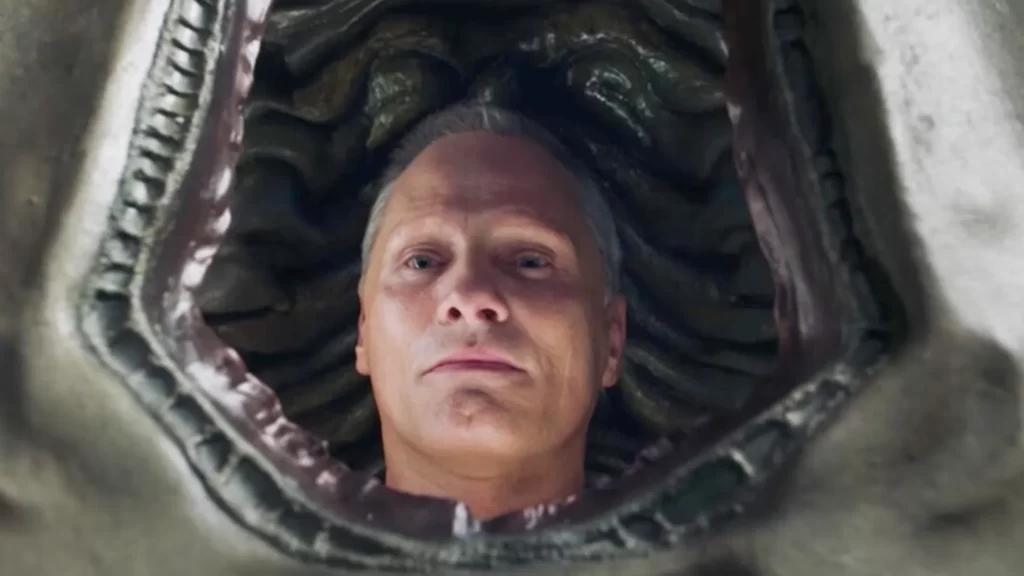Is Cronenberg’s comeback brilliant or botched?
I’ve always felt like biopunk is a highly underrated genre, especially with how much screentime cyberpunk gets in mainstream media. The transhumanist dilemma that those works always delve into felt silly when the delineation between man and machine is so apparent.
But biopunk is a different beast altogether. What if those shiny new organs weren’t cybernetic, but organic, and perfectly melded with your own flesh? What if they were grown inside of and on your own body? At what point does the invasive flesh become native? How many new organs must be added until you’re not human? I mean, how human is humanity?
This idea is where David Cronenberg’s triumphant return to filmmaking, Crimes of the Future, dives deep like an exploratory biopsy. The philosophy of self in relation to the human body, culture, sex, morality, and everything in between is the heart of this film, and it’s a heart that beats hard enough for you to hear it from across the room. It’s a heart full of love and intrigue.
We follow performance artists Saul Tenser (Viggo Mortensen) and Caprice (Lea Sydoux), a duo specializing in artistic surgeries. They extract mysterious organs being sprouted de novo in the sickened Tenser’s body. As Tenser suffers from “Accelerated Evolutionary Syndrome,” a widespread conspiracy involving Tenser’s groupies, a reviled cult, and the highly bureaucratic government of this world seems to close in around the mesmerizing art he and his lover perform. All the while, a quiet biological disaster looms in the background of their dilapidated dystopia: human beings are no longer able to feel pain, leading to increasingly extreme displays of surgery and the popularization of self-harm for entertainment.
This film has been widely described as sci-fi body horror, and while I agree, for the most part, I also think that a large element of this film is more the sci-fi thriller on a romantic streak, something that the body horror is embedded in. This film’s most gruesome and hard to stomach death is undoubtedly horror, horror so good I felt a tingling in my neck for a few minutes after it. But its framing felt reminiscent of a hit in a mob film, and one of the characters even refers to it as an assassination.
Compared to the rest of Cronenberg’s filmography, Crimes of the Future isn’t unique in this way. Videodrome feels like a spy film where our main character doesn’t even know what side he’s on, and Existenz itself is a full-on meta-psychological thriller. In an intuitive move, this film contains homages and echoes of both of those films plot-wise; if you can believe it, even a large part of the story resembles The Fly.
Overall, the movie ends up feeling self-referential to Cronenberg’s previous films, but in a way that seems fond of them and utilizes them transformatively rather than rehashing the material (even the title is transplanted from another of his films despite not being related to it). Cronenberg gives us a bizarre and enrapturing love story between two characters in an uncertain world, finding comfort together as everything around them crumbles.
And yes, there happens to be freaky deeky surgical sex going on in this relationship, but who are we to kink shame?
As expected, the special effects here are fleshy, uncomfortably squishy, and organically out of place in the cold world around them, so classic Cronenberg. However, some of them feel much too animatronic, and you can tell exactly which ones got the most attention. The highlight of these is the SARK, a bone-plated, biomechanical, autopsy performing sarcophagus. It’s the anchor point for some of the film’s most intimate and painful moments, where Mortensen and especially Seydoux excel. The latter has a gothic and heart-wrenching speech that she pours her heart and soul into at the film’s climax. While the dialogue feels stilted when exposition is on the table, the chemistry between Saul and Caprice is subtle and torrid, saving this film from some of its monotony.
For a film about eccentric performers, it ironically squanders its greatest resource: Kristen Stewart, playing the unfortunately unforgettable Timlin. From the moment she’s first onscreen, she portrays the most perverse and strange character of the cast with a palpable and, at times, borderline comedic arousal. She’s awkward, erotically attuned to Tenser, and behaves like her mind is moving too fast to keep up with her physical, quaking need for recognition from him; it’s just so much fun to watch!
I don’t say unfortunately unforgettable because I dislike Stewart, but because she is irritatingly absent from the film for such an important player, both as an actress and an arm of the narrative. For some light spoilers, Timlin spends her final scene skulking around a corner rather than interacting with any of the main players, which is a crying shame since she could have been used so much more. The same could even be said for Welket Bungué’s Detective Cope, but it’s Stewart who was truly robbed here. That, on top of a potently abrupt ending, left me wanting more, for better or worse.
BOTTOMLINE: Cronenberg delivers a film that feels like looking back fondly on his most inventive works and creates a dramatically heavy piece. While it’s just shy of being truly great due to some of its choices, it’s an experience that grabs you and keeps you under the knife until it’s over. The haruspicy reads: get into the guts of this strange medical daydream and see this in theatres now.
